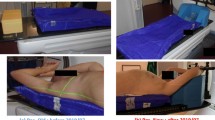Purpose:
To evaluate the precision of image-guided radiotherapy (IGRT) using cone-beam computed tomography (CB-CT) for volume imaging and a robotic couch for correcting setup errors in six degrees of freedom.
Patients and Methods:
47 consecutive patients with 372 fractions were classified according to whether a patient fixation device was used (patfix: n = 28) or not (patnon-fix: n = 19). Prior to treatment a CB-CT was acquired and translational and rotational setup errors were corrected online without an action level using a robotic couch (HexaPOD). A second CB-CT was acquired after the correction process and after treatment in 134 and 238 fractions, respectively.
Results:
In 17 fractions (4.6%) rotational errors > 3° exceeded the motion range of the HexaPOD. Errors (3D vector) after the correction process were significantly smaller for patfix compared to patnon-fix (p < 0.001): 0.9 mm ± 0.5 mm and 1.6 mm ± 0.8 mm, respectively. For patnon-fix the correction of rotational errors resulted in displacements of the patients on the angled couch of 0.6 mm/1°. Intrafractional motion further decreased precision in patnon-fix but not in patfix.
Conclusion:
Very high precision in cranial and extracranial treatment of immobilized patients was demonstrated. Without application of adequate immobilization the correction of rotational errors and intrafractional patient motion significantly decreased the accuracy of the online correction protocol.
Ziel:
Untersucht wurde die Präzision eines bildgestützten Bestrahlungsprotokolls, basierend auf Volumenbildgebung mittels Cone-Beam-Computertomographie (CB-CT) und Korrektur von Lagerungsfehlern in sechs Freiheitsgraden.
Patienten und Methodik:
47 Patienten mit 372 Behandlungsfraktionen wurden ausgewertet: Differenziert wurde zwischen Patienten, die auf dem Behandlungstisch fixiert wurden (patfix: n = 28) oder nicht (patnon-fix: n = 19). Vor der Behandlung wurde ein CB-CT angefertigt, und translatorische und rotatorische Lagerungsfehler wurden vollständig mittels eines robotischen Behandlungstisches (HexaPOD) korrigiert. Bildgebung nach der Fehlerkorrektur und nach der Behandlung wurde in jeweils 134 und 238 Fraktionen durchgeführt.
Ergebnisse:
Bei 17 Fraktionen (4,6%) überschritten die Rotationsfehler die Reichweite des HexaPOD von 3°. Fehler nach der Korrektur (3D-Vektor) waren bei patnon-fix im Vergleich zu patfix signifikant größer (p < 0,001): 1,6 mm ± 0,8 mm versus 0,9 mm ± 0,5 mm. Bei patnon-fix führte die Korrektur von Rotationsfehlern zu einer Verlagerung der Patienten auf dem abgewinkelten HexaPOD von 0,6 mm/1°. Intrafraktionelle Patientenbewegung resultierte in weiteren Fehlern bei patnon-fix, jedoch nicht bei patfix.
Schlussfolgerung:
Bei Immobilisierung der Patienten wurde eine Präzision mittels bildgestützter Radiotherapie von 1 mm und 1° erreicht. Ohne ausreichende Immobilisation reduzieren Verlagerungen nach Korrektur von Rotationsfehlern und intrafraktionelle Patientenbewegungen den Nutzen eines solches Behandlungsprotokolls erheblich.
Similar content being viewed by others
Author information
Authors and Affiliations
Corresponding author
Rights and permissions
About this article
Cite this article
Guckenberger, M., Meyer, J., Wilbert, J. et al. Precision of Image-Guided Radiotherapy (IGRT) in Six Degrees of Freedom and Limitations in Clinical Practice. Strahlenther Onkol 183, 307–313 (2007). https://doi.org/10.1007/s00066-007-1695-0
Received:
Accepted:
Issue Date:
DOI: https://doi.org/10.1007/s00066-007-1695-0
Key Words:
- Image-guided radiotherapy (IGRT)
- Cone-beam CT
- Rotational setup errors
- Frameless stereotactic radiotherapy
- Stereotactic body treatment (SBRT)




